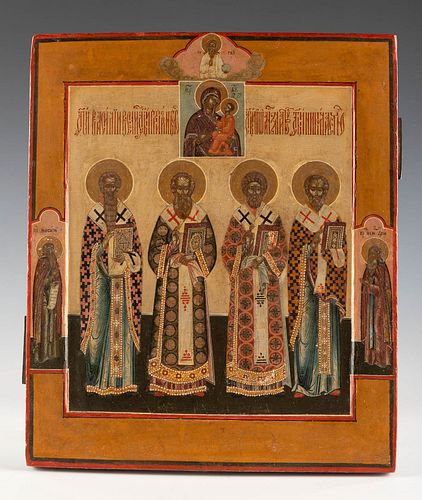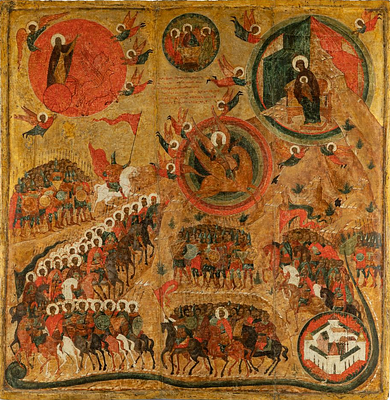Russian school, 19th century. "Basil the Great, Gregory Nazianzen, John Chrysostom". Tempera on panel.
Lot 57
About Seller
Setdart Auction House
Carrer Aragó 346
Barcelona
Spain
Setdart Subastas was born in 2004 and is currently the first online art auction in Spain with solidity, prestige and reliability guaranteed by our more than 60,000 users. Setdart has a young, dynamic and enterprising team ready to successfully manage the purchase and sale of art works through custom...Read more
Estimate:
EUR€1,200 - EUR€1,500
$1,250 - $1,562.50
Absentee vs Live bid
Two ways to bid:
- Leave a max absentee bid and the platform will bid on your behalf up to your maximum bid during the live auction.
- Bid live during the auction and your bids will be submitted real-time to the auctioneer.
Bid Increments
| Price | Bid Increment |
|---|---|
| EUR€0 | EUR€10 |
| EUR€200 | EUR€25 |
| EUR€500 | EUR€50 |
| EUR€1,000 | EUR€100 |
| EUR€3,000 | EUR€200 |
| EUR€5,000 | EUR€500 |
| EUR€10,000 | EUR€1,000 |
| EUR€20,000 | EUR€2,000 |
| EUR€50,000 | EUR€5,000 |
About Auction
By Setdart Auction House
Sep 23, 2021
Set Reminder
2021-09-23 10:00:00
2021-09-23 10:00:00
America/New_York
Bidsquare
Bidsquare : RUSSIAN ICONS
https://www.bidsquare.com/auctions/setdart-auction-house/russian-icons-7431
Setdart Auction House sofia@setdart.com
Setdart Auction House sofia@setdart.com
- Lot Description
Russian school, 19th century. "Basil the Great, Gregory Nazianzen, John Chrysostom". Tempera on panel. Measurements: 36 x 30.5 cm. In this icon are represented three great hierarchs, masters of the Church, outstanding theologians, writers and preachers of their time, most venerated in the countries of the Christian world. Basil the Great (c. 329-379), archbishop of Caesarea, fought the Arian heresy. His co-religionist, Gregory Nazianzen (329-389), was bishop of Sasimia and later of Nazareth. After the death of his close friend Basil the Great, he had to assume the rank of archbishop of Constantinople against his will. Gregory wrote an elaborate treatise, which interpreted sacred characters such as the Holy Trinity. Like Basil the Great, Gregory Nazianzen fought against heresies. His younger contemporary, John Chrysostom (347-407), bishop of Antioch, later patriarch of Constantinople, was deposed, exiled and died there; an outstanding interpreter of Holy Scripture. Famous as a preacher and denouncer of the sins of the powerful. Basil the Great, Gregory the Theologian and John Chrysostom are the creators of the liturgy. The writings of all three hierarchs were known in Old Rus in Slavic translations by the 11th century at the latest. In accordance with their eminent position among the hierarchs of the Orthodox Church, bearers and preachers of Divine Wisdom, they were, as a rule, represented in all monumental ensembles of the 11th-12th centuries in the composition of the office of saints in the apses of churches. In Pskov, probably, the three masters of the church were honoured for a long time. Several churches were dedicated to them there. The depiction of a group of hierarchs in the pose of solemn preachers has been widespread in Russian icon painting since the 15th century. The icon of interest presents the established canon of depicting this group of saints. They are always depicted isocephalically, i.e. of the same size and height. In their hands they hold the closed Gospel, the left hand is held in a gesture of blessing with two fingers. In the case of the present icon, the three saints are accompanied by St. Nicholas the Miracle-worker, the figure on the far right. In the central register of the icon rests the icon of the Mother of God with the Child Jesus, Odighidria type, and above this composition stands the Father God. The composition also acquires a greater, almost metaphysical depth. On both sides of the icon are depictions of two venerables, smaller than the saints, thus emphasising the importance of the four protagonists in the central register.
- Shipping Info
-
In-house shipping available. Please inquire at admin@setdart.com.
-
- Buyer's Premium



 EUR
EUR CAD
CAD AUD
AUD GBP
GBP MXN
MXN HKD
HKD CNY
CNY MYR
MYR SEK
SEK SGD
SGD CHF
CHF THB
THB
















